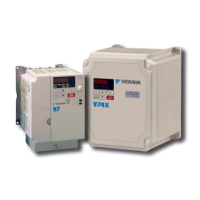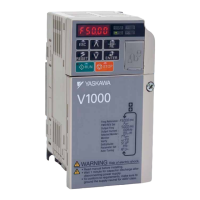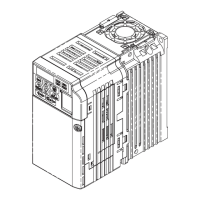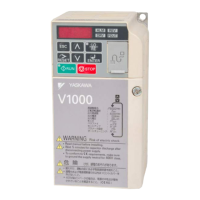u
Open Loop Vector (OLV) Motor Control Method Tuning
Table 6.2 Parameters for Tuning the Drive in OLV Motor Control Method
Problem Parameter No. Corrective Action
Default
Value
Suggested
Setting
• Poor motor torque and speed
response
• Control motor hunting and
oscillation at speeds between 10
and 40 Hz.
AFR Gain
(n2-01)
• If motor torque and speed response are too slow,
gradually decrease the setting by 0.05.
• If motor hunting and oscillation occur, gradually
increase the setting by 0.05.
<1>
0.50 to 2.00
• Poor motor torque and speed
response
• Control motor hunting and
oscillation at speeds between 10
and 40 Hz.
AFR Time Constant 1
(n2-02)
• To improve motor torque speed response,
gradually reduce this setting by 10 ms and check
the performance.
• If motor hunting and oscillation occur as a result
of load inertia, gradually increase the setting by
50 ms and check the performance.
Note: Ensure that n2-02 ≤ n2-03. When making
adjustments to n2-02, set C4-02 (Torque
Compensation Primary Delay Time Constant 1)
accordingly.
50 ms 50 to 2000 ms
• Overvoltage trips when
accelerating, decelerating, or
during sudden speed or load
changes.
AFR Time Constant 2
(n2-03)
• If overvoltage trips occur, gradually increase this
setting by 50 ms.
• If response is slow, gradually reduce this setting
by 10 ms.
Note: Ensure that n2-02 ≤ n2-03. When making
adjustments to n2-03, increase the value of C4-06
(Torque Compensation Primary Delay Time 2)
proportionally.
750 ms 750 to 2000 ms
Torque Compensation
Primary Delay Time
Constant 2 (C4-06)
• If overvoltage trips occur, gradually increase this
setting by 10 ms and check the performance.
• If response is slow, gradually reduce this setting
by 2 ms and check the performance.
Note: Ensure that C4-02 ≤ C4-06. When changing
C4-06 (Torque Compensation Primary Delay Time
Constant 2), increase the value of n2-03
proportionally.
150 ms 150 to 750 ms
• Poor motor torque and speed
response
• Motor hunting and oscillation.
Torque Compensation
Primary Delay Time
Constant 1
(C4-02)
• To improve motor torque speed response,
gradually reduce this setting by 2 ms and check
the performance.
• If motor hunting and oscillation occur, gradually
increase this setting by 10 ms.
Note: Ensure that C4-02 ≤ C4-06. When making
adjustments to C4-02, increase n2-02 (AFR Time
Constant) proportionally.
20 ms
<2>
20 to 100 ms
• Poor speed response and
stability
Slip Compensation
Primary Delay Time
Constant (C3-02)
• If response is slow, gradually decrease the setting
by 10 ms.
• If speed is unstable, gradually increase the setting
by 10 ms.
200 ms
<2>
100 to 500 ms
• Poor speed precision
Slip Compensation
Gain (C3-01)
• If speed is too slow, gradually increase the setting
by 0.1 ms.
• If speed is too fast, gradually decrease the setting
by 0.1 ms.
1.0
<2>
0.5 to 1.5
• Motor noise
• Control motor hunting and
oscillation occur at speeds
below 10 Hz.
Carrier Frequency
Selection (C6-02)
• If there is too much motor noise, the carrier
frequency is too high.
• If motor hunting and oscillation occur at low
speeds, reduce the carrier frequency.
• The default setting for the carrier frequency
depends on the drive capacity (o2-04) and Drive
Duty Selection (C6-01).
7 (Swing PWM
1)
0 to the default
setting
• Poor motor torque at low speeds
• Poor speed response
• Motor instability at motor start.
Mid Output Voltage A
(E1-08)
Minimum Output
Voltage (E1-10)
• If motor torque and speed response are too slow,
increase the setting.
• If the motor exhibits excessive instability at start-
up, reduce the setting.
Note: The default value is for 200 V class units.
Double this value when using a 400 V class drive.
When working with a relatively light load,
increasing this value too much can create an
excessively high of a torque reference.
E1-08: 12.0 V
<2>
E1-10: 2.5 V
<2>
Initial ±2 V
<1> Default setting is determined by drive model.
Models BA0001 to BA0012, 2A0001 to 2A0020, and 4A0001 to 4A0011: Setting 1.00.
Models BA0018, 2A0030 to 2A0069, and 4A0018 to 4A0038: Setting 1.50.
6.2 Motor Performance Fine Tuning
YASKAWA ELECTRIC SIEP C710606 16C YASKAWA AC Drive – V1000 Technical Manual
247
6
Troubleshooting
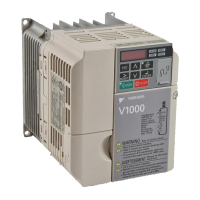
